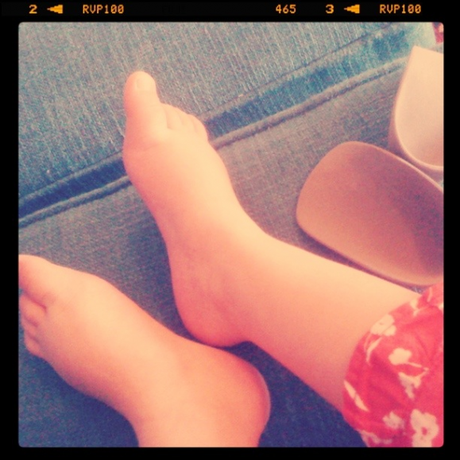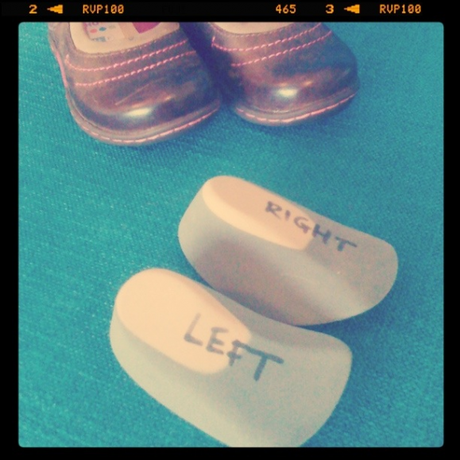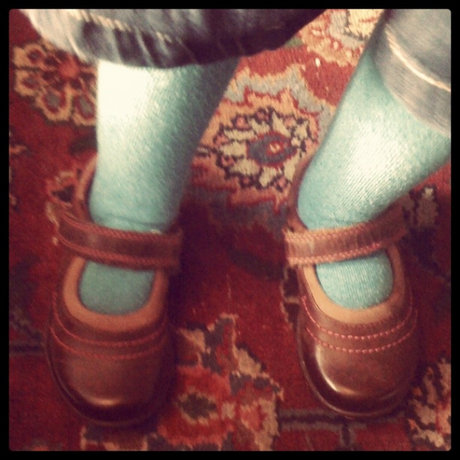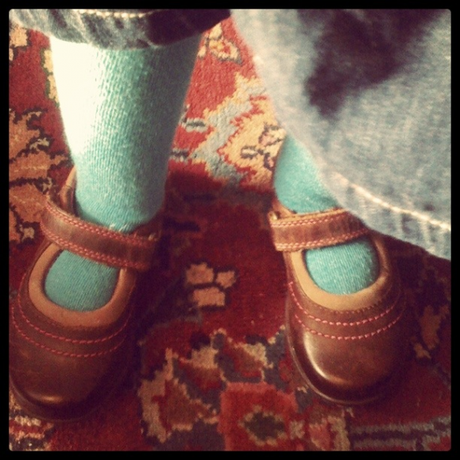Isobel has started pronating her feet during standing practice. It’s not a good look, the way her soles roll outward so that she appears knock-kneed when upright.
For a time during the summer, it looked as though Isobel had got standing with feet level down to a T – but then after that, it was as if she’d never tried.
It’s gone on for about seven months now, a combination of CP, continuing GDD, and the developing musculature of a pair of feet more used to their owner lying supine.
I don’t think it helped, either, that the rubber-soled Clarks walkers we’d got off eBay previously were slipper-soft. But then at the time, there was no telling how Isobel’s feet would grow.
Initially the pronation was subtle, and barely noticeable. PACE suggested we get a pair of Piedro boots from her physio for standing/walking practice, and loaned us another pair in the meantime.

The physio disagreed, citing them too OTT for Isobel’s needs, and ordered moulded blue plastic insoles instead. We even bought a new pair of shoes – in a fetching shade of violet – one size bigger specifically.
It didn’t work. Isobel stood as though she had stones in her shoes. Funnily enough, around this time she took her first steps in the loaned Piedro boots without them.
It’s become a conundrum. Miles thinks the logic behind the Piedros is similar to that behind ice-skating boots: learners pick up skills more efficiently in high lace-up styles due to the ample support given to the ankle, enabling them to build up strength in that area.
Even so, we agreed that Isobel should have both options anyway, just to see what would happen.
So back she went to the orthotics clinic, where her feet were plunged into a piece of moulding foam that resembled the sort flower-arrangers use. Two weeks later the bespoke insoles came back in grey.
Unlike the blue plastic ones, these were softer and kinder to the foot, and covered just three-quarters of the sole. To avoid confusion, the orthotics specialist marked them right and left, and Isobel seemed perfectly happy standing with them on.

“Start with 20 minutes a day,” I was told, “gradually building up to all day. You may get red marks on the soles of Isobel’s feet to begin with, but if they go after a few minutes of taking the insoles out, that’s fine. If they don’t, or they start bleeding, email me.”
We had to get more shoes, though; the violet shoes didn’t have the right heel – they were funky moulded rubber rather than the sturdy L-shape that the insoles needed to work properly – and the black Mary-Janes we’d bought as an alternative were too small.
The next day, I packed Isobel’s new shoes with the insoles in her PACE bag instead of the Piedro boots. I wanted to see how she got on with them in her sessions. These were, after all, the strongest test of her will to stand and walk.
But the feedback wasn’t what I expected. “Isobel wouldn’t walk in the insoles,” Miles said upon returning home. “Her legs kept giving way, and she stood with her soles badly turned outwards. Szilvia also found red marks on them afterwards.”
I wasn’t comfortable. Were the insoles really worth this? The physio had told me that some CP kids ended up wearing them for the rest of their lives. Others were able to discard them once they’d gained better postural control with their feet.
I decided to try a change of approach, and keep the Piedros for PACE sessions only.
But even I had to do a double-take when I saw Isobel’s feet pronate during standing practice at home too. It was most peculiar. I took the insoles off, and upon trying again Isobel did a little excitable jig. Clearly, she found them a discomfort.
The physio was adamant. “Keep on with them,” she advised, “or Isobel’s soles may roll outwards permanently.”
Well, Isobel has had these insoles for about two months now, and we’re still not quite convinced. This is what her feet look like with them on:

And this is what they look like without:

Spot the difference.
The physio says we have to bring Isobel’s feet into parallel for the insoles to have an effect, but we achieve the same outcome without anyway. Isobel also tends to walk much better insole-free – in fact, she can’t wait to get started.
So again, who is right?

